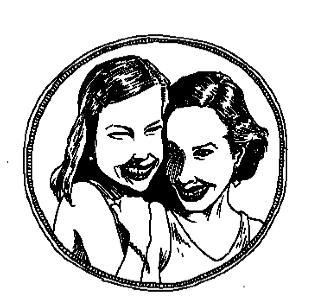SUGAR SERIAL
For the past three months I have been hiding my reading material from other riders on the subway. If you were to look behind my magazine, you would see one stash of serial novels—the Sweet Valley High novels, starring identical twin sisters Jessica and Elizabeth Wakefield, “created” (but not always “written”) by Francine Pascal.
But tonight I’m sitting in a bar in Brooklyn asking everyone around me to talk about twins.
The bartenders are not twins—one is twenty-one, the other twenty-three—but they are sisters. And they are both gorgeous blondes. This seems to sell drinks. The owner insists that the sisters work the same shifts.
It’s easy enough to find two gorgeous young women to bartend. But why is it twice as appealing when those two young women appear related?
Ask the people at Coors. Like my local bartender, they found that employing two look-alike blond girls was a really good way to get boys to buy beer. Their most successful ad campaign of the last year features two twenty-six-year-old identical twins, Diane and Elaine Klimaszewski. Apart, they are ordinary, beautiful blond beer broads in bikinis; together they are extraordinary blond beer broads in bikinis. Recently, Shari Waxman wrote an article in Salon.com in preparation for which she went around and asked a bunch of her guy friends to explain why, exactly, they had a thing for twins. If the twins fantasy were actually consummated, wouldn’t they be bothered by that incest thing?
Not really. One of the most articulate responses was “There are two of them and they are the same and I can have sex with both of them at the same time and did I mention that they are the same?”
Watching the boys watching the two girls at my local bar, it’s easy to see the appeal. Their sisterhood gives them a kind of easy girl-on-girl intimacy. The girls play to their audience—first wrapping their arms around each other, then practicing fake karate kicks on each other.
Blond twins must top the list of the things most likely to sell stuff. Mary Kate and Ashley Olsen—despite being insipid, and not that talented or even cute—are apparently, at seventeen, the richest teenagers in America. And back in the eighties, a pair of blond identical twins were used to sell serial novels to eight- to twelve-year-old girls, a demographic that buys the things they like at approximately the same rate that some people buy crack.
I haven’t been between the ages of eight and twelve for a good long time now. But serial novels are still my crack. I love the endless descriptions of clothes, the florid adjectives used to describe improbable hair, eye,...
You have reached your article limit
Sign up for a digital subscription and continue reading all new issues, plus our entire archives, for just $1.50/month.
Already a subscriber? Sign in





